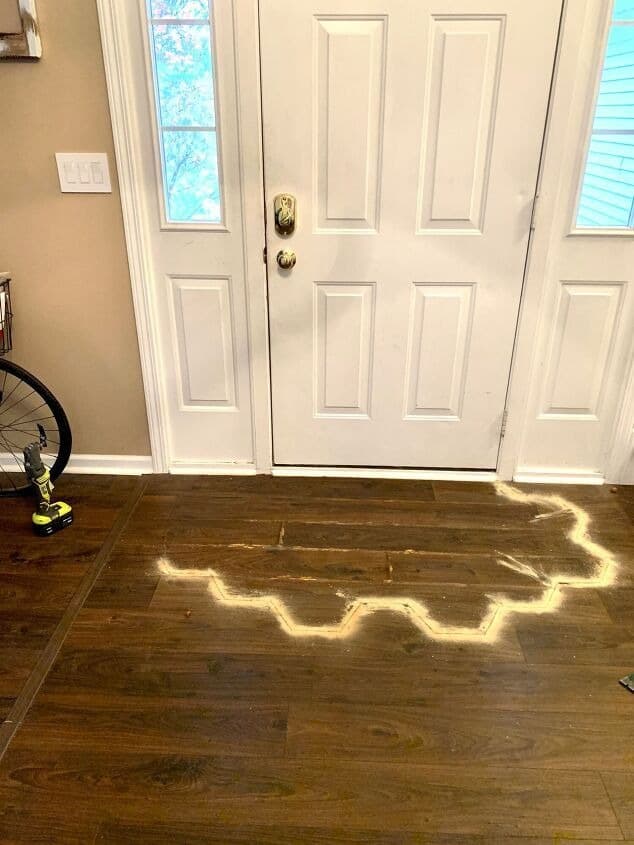Inspiration: Our kitchen floor
I could use the same tile with the same method here at our entry, and this would also keep us from having too many different kinds of flooring on this main level of our house. This porcelain tile I already know is durable, easy to clean, and textured enough not to be slippery. The tile here at our entry wouldn’t have to be extensive, instead just covering enough of the floor to act like an entry “rug” (and also big enough to get rid of the ruined flooring).
So that was my plan. I needed to get rid of the cat’s mess, plus this sounded like a little, manageable project after my massive bathroom remodel! It was also a plus that I already had all the supplies except the tile, so this was a pretty cheap fix too. (The $250 listed for this project is if you have to buy everything from scratch. The tile was only a little over $100.)
Supplies:
Hexagon floor tile (mine is from Mission Stone & Tile)
AquaDefense and/or Schluter membrane
Rapid-setting thin set mortar
Grout
Caulk
Step 1: Plan tile layout and outline. Once my tile arrived, my 4-year-old and I had a grand time planning what shape we’d make the tiled entry. We made some fun shapes, but I ended up laying the tile right over the ruined part of the floor (after I cleaned it as best I could).
Planned shape
I’d guessed correctly (sigh of relief) that we’d only need 1 box. I spaced the tiles exactly how I wanted to grout them, and I made sure to leave out a tile to cut for my filler pieces against our door.
With the tiles down where I wanted them, I took a Sharpie marker and drew right on the floor to make an outline of this plan. I made sure to trace along the tiles’ edge generously, leaving myself some extra space so I could adjust the tiles slightly if I needed. This would also give me room to caulk between the tiles and the existing flooring, just like I would grout the spaces between the tiles themselves.
Step 2: Cut out old flooring. This part was messy and gross. But, if your flooring isn’t saturated in cranky old cat spite, you’ll probably be fine. Moving along my traced line, I used my oscillating saw tool to cut the old flooring. This little tool is definitely one of my favorites, and it’s easy to get nice clean cuts in all those hexagon corners.
Cutting along my traces line
You can also use a circular saw to cut the long, straight cuts. If you do this, make sure the depth is set to only cut through your flooring and NOT into the subfloor. I used a circular saw thusly when doing our kitchen, and it’s certainly faster! For this project, however, my circular saw was out of commission.  Oh, well. For all the corners and the places right next to the wall/door, I needed my oscillating tool anyway.
Oh, well. For all the corners and the places right next to the wall/door, I needed my oscillating tool anyway.
Once my cutting was complete, I used a hammer and pried up one of the boards along my cut line. From there, it was easy to disassemble and remove the flooring – like taking apart a puzzle. I had a garbage bag ready nearby, so I shoved the old flooring into the bag, swept up any debris, and hauled the bag out to the trash. So long, ruined floor!
Removing the flooring
Step 3: Apply waterproofing. In my kitchen, I’d covered the whole space with Schluter Ditra membrane for total waterproofing. But, that was a bit expensive and seemed overkill for just a little entry space. As an alternative, I had some scrap Schluter Kerdi membrane (much thinner and cheaper) and a lot of AquaDefense liquid membrane left from my bathroom remodel, so I decided to try laying down the Kerdi and then applying a few coats of the liquid membrane on top of that.
After sweeping and making sure the floor was clean, I spread the Kerdi over the space, grabbed a disposable brush, and painted on the AquaDefense. It went on nice and thick, acted a bit like glue to hold the Kerdi in place, and I only had to wait about an hour between coats. Did I have to do 2 coats? Probably not, but I liked getting the surface nice and even.
AquaDefense drying
Step 4: Mix mortar and lay tile. See how quickly this project got to the fun part?! Once the AquaDefense was dry, I got an old ice cream bucket and a paint stir stick. Yep, nothing but professional tools around here.  I used rapid-setting thin set mortar, but follow the mixing instructions of whatever kind you use. One trick I’ve found is that it helps to add some water first, then pour in the mortar, then add more water as needed – this makes it much easier to stir up and get an even consistency faster. Once mine was mixed, I saw that I’d only filled the bucket about a quarter full, and this made plenty of mortar for my space.
I used rapid-setting thin set mortar, but follow the mixing instructions of whatever kind you use. One trick I’ve found is that it helps to add some water first, then pour in the mortar, then add more water as needed – this makes it much easier to stir up and get an even consistency faster. Once mine was mixed, I saw that I’d only filled the bucket about a quarter full, and this made plenty of mortar for my space.
Because it was such a small area, I simply poured the mortar in a puddle and then spread it around with my stir stick until I had an even level of mortar all over. The idea is to get it not too thick, but enough to cover the floor so you can’t see what’s under it – this was easy to see since my AquaDefense underneath was blue!
As soon as my mortar was down, I started bringing over my tiles and put them in place one at a time. I started with my top right tile that went against the door/wall in my cut-out space. This tile I made sure to press down and wiggle a bit to stick in the mortar, plus I made sure there was a bit of space between the tile and the cut flooring – like a grout line.
From there, I picked which tiles looked best next to each other and put them in place, making sure they were spaced evenly for grout lines. If some mortar oozed up between the tiles, I made sure to wipe it out so it wouldn’t be too high and show up through the grout.
With all my whole tiles in place, I took the last tile out to my garage and used a tile saw to cut it in half. (You can rent a tile saw for pretty cheap.) This was easy enough, and then I put both cut pieces where they needed to go to complete the puzzle.
All tiles in!
After that, I babysat the tiles for a few hours to make sure no dogs, cats, or children stepped on the tiles and messed them up. This is largely the reason I use rapid-setting mortar! Once I could push on a tile and it didn’t budge, I stopped worrying and left the tiles to set overnight.
Step 5: Grout. The next day, I used the same grout for this entry as I did for our kitchen. I don’t really have any quick tips for grout – it takes a bit of patience, which I often don’t have.  Basically, I mixed it up in another bucket and then glopped it on, wiping it back and forth over the spaces between tiles until all the gaps were filled. Sometimes it will look like a gap is filled, but be sure to go over the grout lines from another angle to be sure there’s not a secret pocket of air under there waiting to ruin your day.
Basically, I mixed it up in another bucket and then glopped it on, wiping it back and forth over the spaces between tiles until all the gaps were filled. Sometimes it will look like a gap is filled, but be sure to go over the grout lines from another angle to be sure there’s not a secret pocket of air under there waiting to ruin your day.
For now, mostly ignore the exterior gaps between the tiles and the other flooring. These edges should be caulked, not grouted, because caulk will flex better with any shift in the flooring. However, there were some spots where the edging was a bigger gap than I’d anticipated, and these I helped fill with a bit of grout. I also did grout the larger space between the tile and under our door. I’ll probably still put quarter-round along this door at some point, but I wanted the added protection of grout there too.
Grout on
All this grouting DOES make a mess. I think that’s unavoidable. But after you get all the grout lines done and let it sit for a bit (read the instructions of your grout for how long!), you can start wiping it off the tiles with a wet sponge from a bucket of water. This is partly satisfying and partly a good way to feel like Cinderella.
Once happy with my grout job between the tiles, I rested for a bit and let the grout set up. But one thing about grout is that there will always be a grout film even after you wash it off repeatedly. So, I kept my sponge damp and kept wiping the drying grout off my tiles.
And here’s where I have a useful tip! When there’s just a faint film of grout on the tiles, I take a baby wipe and scrub away the film. I can’t explain the science of whatever chemicals are involved, but I swear these baby wipes work better than anything else I’ve tried to remove grout film!
Step 6: Caulk the edges. This last step really adds the finishing touch. If any of your cuts were a little wonky, covering with smooth caulk lines hides these goofs. I had a white caulk that was the same color as my grout, so that blends it all together to look the same too.
With my caulk gun, I squeezed out a (semi) even line of caulk to fill the space running between my tiles and the existing floor. Then I used another baby wipe (versatile little things, huh?!) to smooth the caulk all around and along my outline. In a few places it got onto my tile and/or my old flooring, so I just wiped it off and kept going. This took a bit of time, but once I was done it looked so nice.
AFTER!
That’s it! Now instead of a ruined floor under a mat, we have a cool floor that can hold up on its own. We’ve already taken off many snow-covered shoes here, and it’s a perfect way not to worry about getting a rug dirty or sopping wet…from shoes or otherwise, but let’s focus on the shoes. 


